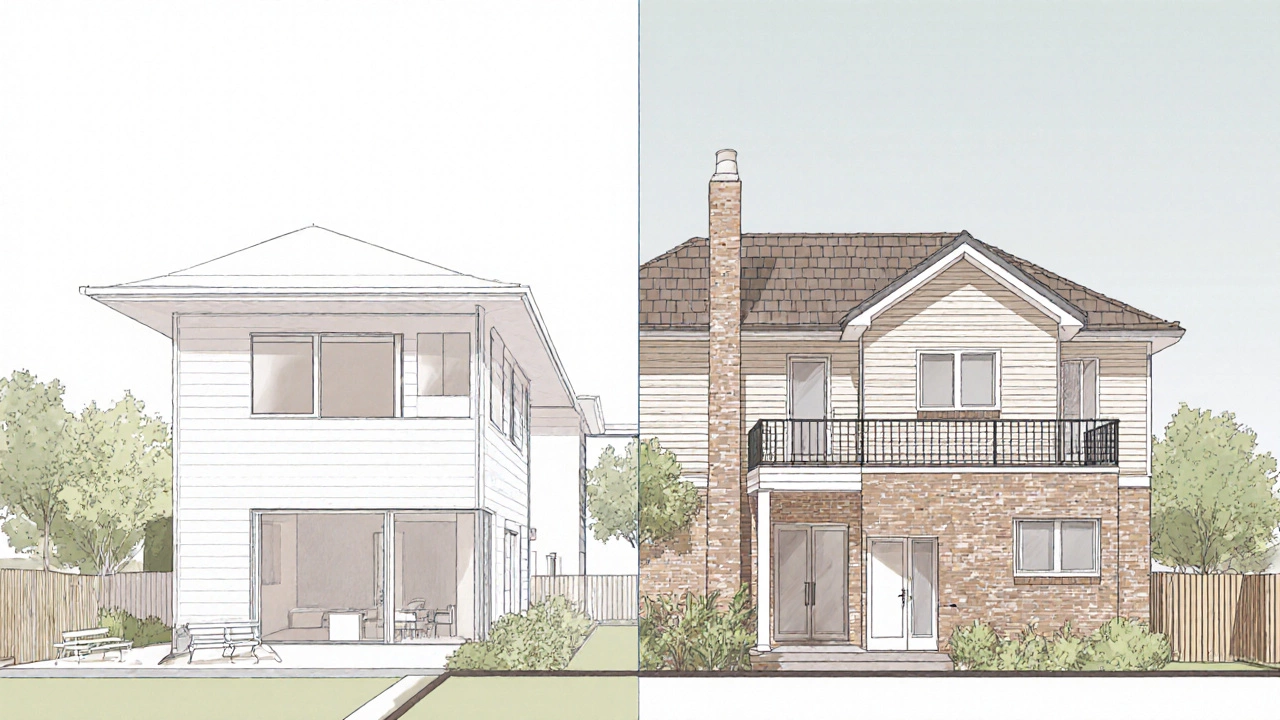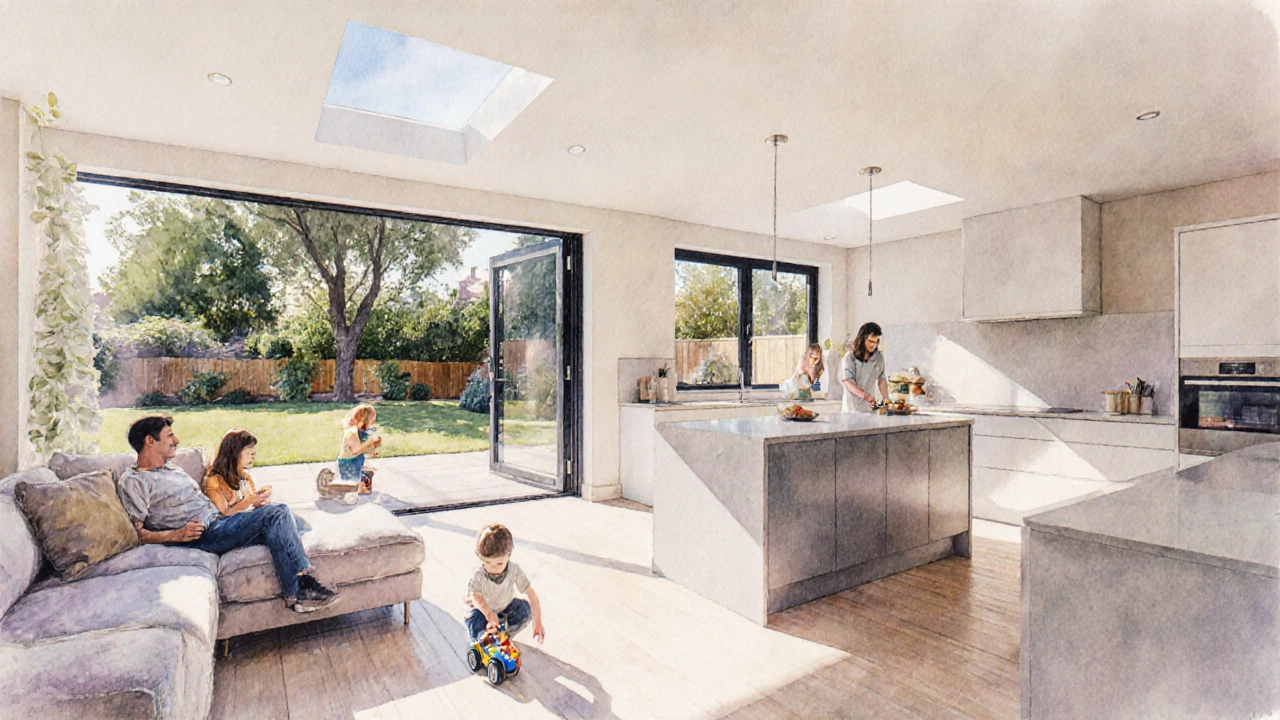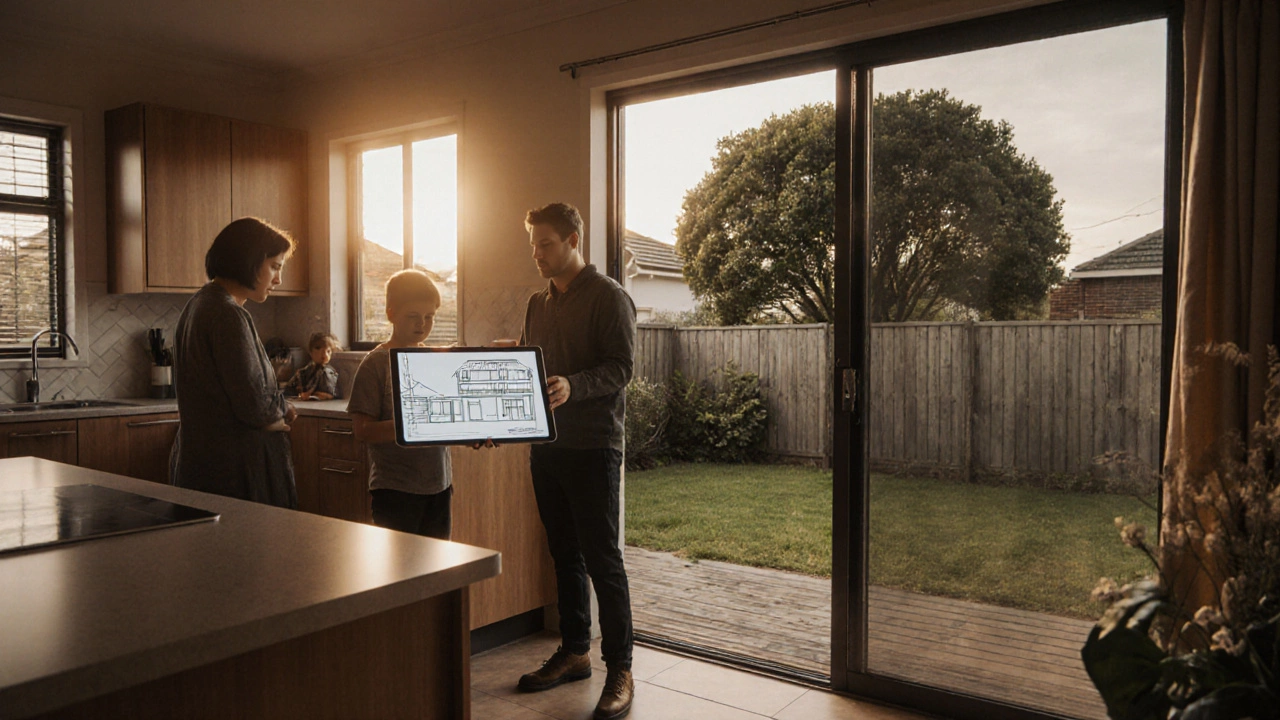Home Extension Cost Calculator
Calculate Your Extension Costs
Cost Comparison
Ground-Floor Extension
$9,500-$12,000/m²Base Cost: $
Permit Fees: $2,900
Total: $
Vertical Build-Up
$11,000-$14,500/m²Base Cost: $
Permit Fees: $3,800
Total: $
Which Option Saves Money?
Timeline: Ground-floor: 12-18 weeks | Vertical: 14-22 weeks
Cost Breakdown
| Factor | Ground-Floor | Vertical |
|---|---|---|
| Per m² Cost | $9,500-$12,000 | $11,000-$14,500 |
| Permit Fees | $2,900 | $3,800 |
| Typical Timeline | 12-18 weeks | 14-22 weeks |
When you’re stuck with a cramped kitchen, a bedroom that feels more like a closet, or just a growing family, the first question that pops up is: house extension. But should you add a new wing on the ground floor or push the roof higher and build up? The answer isn’t a simple yes or no - it depends on land, budget, council rules, and how you value your time.
House extension is a type of home improvement that adds livable space to an existing dwelling, either by expanding outward (ground‑floor extension) or upward (vertical build‑up). Both approaches aim to increase floor area, improve functionality, and boost resale value, yet they differ dramatically in cost drivers, construction timeline, and regulatory hurdles.Why the Cost Debate Matters
Every homeowner in Auckland knows that construction costs have been on a roller‑coaster ride. Labour rates jumped 12% in 2024, and material price spikes for timber and steel are still echoing from the supply chain crunch of 2023. In that climate, choosing the cheaper route can save thousands - or waste them.
Key Cost Factors for Both Options
- Site constraints: How much land do you own? Is the backyard fenced or sloping?
- Structural considerations: Can your existing roof support added weight?
- Council requirements: Building consent, setbacks, and zoning rules vary for horizontal vs vertical work.
- Material choice: Timber framing vs steel beams, insulation levels, and external cladding.
- Labour rates: Tradespeople charge per hour, but some tasks (like roofing) command premium rates.
Understanding these variables helps you set realistic expectations before you ask for a quote.
Cost per Square Metre: Build Up vs Ground‑Floor Expansion
| Extension Type | Cost (NZD / m²) | Typical Timeline (weeks) | Common Permit Fees |
|---|---|---|---|
| Ground‑floor extension | 9,500 - 12,000 | 12‑18 | ≈ $2,900 (Building Consent) |
| Vertical build‑up (second‑storey) | 11,000 - 14,500 | 14‑22 | ≈ $3,800 (Structural Consent) |
These numbers are averages from three Auckland‑based contractors surveyed in Q2 2025. They already include typical finishes - plasterboard, flooring, and basic kitchen fixtures. Anything premium (marble countertops, high‑end appliances) will push the figures higher.
When Building Up Beats Expanding
Even though the per‑square‑metre price is higher for a second‑storey, there are scenarios where a build‑up actually saves money:
- Limited backyard space: If your lot is tiny or encroached by neighbours, you simply can’t spread out.
- Higher land value than building value: In high‑density suburbs, the land price dwarfs construction costs, making vertical growth more logical.
- Better views and natural light: A higher floor can command a higher resale premium, offsetting the extra build cost.
- Retaining existing landscaping: You avoid re‑grading a garden, keeping mature trees that would otherwise be removed.
When Expanding Is the Money‑Saver
Ground‑floor extensions usually win the cost battle when:
- Ample backyard exists: A 6 m × 8 m plot can accommodate a 4 m × 5 m addition without major earthworks.
- Existing roof can’t bear extra load: Reinforcing a roof is expensive; it’s often cheaper to spread the load across a new ground‑level slab.
- Council setbacks are generous: In many Auckland zones, you can build right up to the property line, minimizing wasted space.
- Fast turnaround needed: Horizontal work often finishes quicker because you skip complex structural calculations.

Regulatory Landscape: What Auckland Council Looks For
Both options require a building consent, but the paperwork differs:
- Ground‑floor extension: You’ll submit site plans, a floor‑area ratio calculation, and a simple structural design if the new walls are timber.
- Vertical build‑up: You must provide a detailed structural analysis, wind‑load calculations, and possibly a heritage assessment if the existing home is over 50 years old.
Auckland Council’s average processing time in 2025 is 10 business days for straightforward ground‑floor work and 15‑20 days for vertical projects. Expect additional costs for specialist reports - a structural engineer can charge $2,500‑$4,000 for a second‑storey assessment.
Hidden Costs You Can’t Ignore
It’s easy to focus on square‑metre price and miss these extras:
- Site preparation: Excavation, shoring, and soil testing can add $1,200‑$2,500 per m² for a ground‑floor build.
- Scaffolding: Required for most build‑up projects; daily hire is about $150‑$200.
- Temporary accommodation: If you need to move out during roof work, budgeting $1,500‑$3,000 for a short stay is wise.
- Insurance uplift: Builders' risk insurance premiums climb 8‑10% for vertical extensions because of higher liability.
Step‑by‑Step Guide to Estimate Your Project
- Define the goal: Is it an extra bedroom, a larger kitchen, or a home office?
- Measure your site: Get the exact dimensions of your lot, setbacks, and roof load capacity (a structural engineer can help).
- Choose the extension type: Sketch a quick layout for both a ground‑floor add‑on and a two‑storey lift‑up.
- Calculate rough cost: Multiply the planned floor area by the average cost per m² from the table above.
- Add fixed fees: Include building consent ($2,900‑$3,800), engineering reports, and any site‑prep costs.
- Compare total budgets: Whichever option stays under your comfort zone wins - remember to factor in a 10% contingency.
- Get three quotes: Provide the same drawings to each contractor to ensure an apples‑to‑apples comparison.
Following this checklist keeps surprises at bay and lets you talk numbers with confidence.
Pro Tips to Trim the Bill
- Standardize dimensions: Using 2‑m modules reduces waste and labour time.
- Reuse existing materials: Salvage bricks or timber from demolition; it can shave $1,000‑$2,000 off.
- Schedule during off‑peak season: Contractors often lower rates in winter when demand slows.
- Bundle services: Ask a single builder for both design and construction - they may give a discount.
Bottom Line: Which Option Is Cheaper for You?
There’s no universal answer. If you have a small backyard, steep slopes, or want better views, a vertical build‑up can be the smarter investment despite the higher per‑square‑metre price. If you own a generous lot, have a strong roof, and need a quick fix, spreading out on the ground floor usually wins on sheer dollars.
Run the numbers, check council rules, and talk to a trustworthy builder. Once you’ve nailed the figures, the decision becomes a lot less stressful.

Does a second‑storey extension increase my property value?
Yes. In Auckland, a well‑executed second‑storey can boost resale value by 8‑12% because it adds premium living space without consuming land.
What’s the fastest way to get council consent?
Prepare complete set drawings, a soil report, and a structural engineer’s certification. Submitting everything at once usually cuts processing time to about 10 business days.
Can I combine both approaches - a small ground‑floor add‑on plus a loft?
Absolutely. A hybrid plan lets you expand horizontally for easy access rooms while adding a loft for private bedrooms. Just remember each part needs separate consent and cost calculations.
How much should I set aside for unexpected costs?
A 10‑15% contingency on top of your total estimate is standard practice. For a $80,000 project, budget an extra $8,000‑$12,000.
Do I need a structural engineer for a ground‑floor extension?
If the new walls are timber framing and the existing foundation is sound, a simple engineer sign‑off may suffice. For larger spans or added load on existing footings, a full structural design is required.

Written by Fletcher Abernathy
View all posts by: Fletcher Abernathy